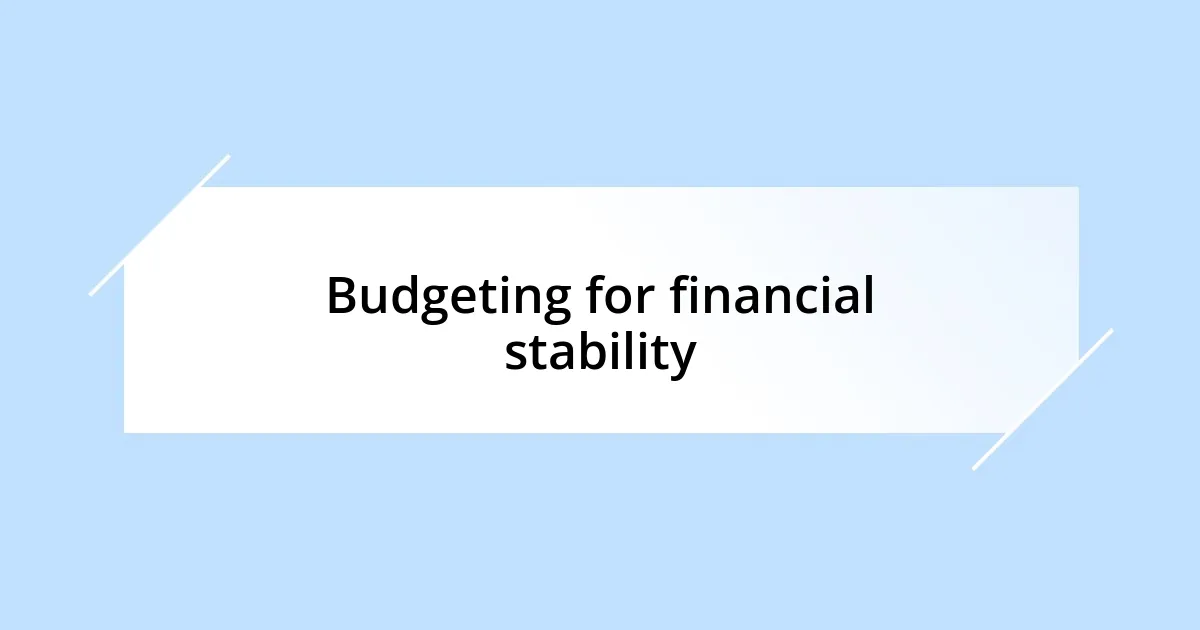Key takeaways:
- Identifying essential expenses helped the author prioritize needs over wants, leading to budget adjustments like cooking at home instead of dining out.
- Creating a flexible budget and tracking all expenses increased financial awareness, allowing for better decision-making and small victories in saving.
- Exploring additional income streams, such as freelance work and side gigs, provided financial relief and opportunities for personal growth.
- Implementing cost-cutting strategies and adjusting lifestyle habits, like hosting potlucks and biking, contributed to significant savings and enhanced well-being.

Understanding rising living costs
Rising living costs can feel overwhelming, can’t they? I remember when my grocery bill spiked one month; it was a wake-up call. I started questioning everything—what happened to the prices, and why do they keep climbing?
It’s fascinating to see how various factors contribute to inflation. I once read an article about supply chain disruptions, and suddenly, it all clicked for me. Those little disruptions in transport or production can lead to significant price hikes, leaving us scrambling to adjust our budgets.
On a more personal note, I’ve had to be creative and strategic in my spending habits. One day, I noticed that my usual coffee shop had jacked up their prices. Instead of indulging daily, I began brewing my own coffee at home. It wasn’t just about saving money; it felt empowering to take control of my spending amid rising costs. Have you found yourself making similar changes?

Identifying essential expenses
Identifying essential expenses requires a clear evaluation of what truly matters in our everyday lives. I’ve learned that differentiating between needs and wants can be eye-opening. For instance, while a gym membership felt essential at one point, I eventually realized that home workouts and outdoor activities provided just the same benefits without the monthly fee. How about you? Have you spotted expenses that turned out to be more of a luxury?
It’s crucial to prioritize necessities such as housing, utilities, and food. I once had the task of reviewing my monthly budget, realizing that I was spending a significant amount on dining out. I decided to set up a meal plan for the week instead, and now not only do I enjoy cooking, but I’ve also seen a noticeable drop in my grocery expenditures. What essential expenses have you reevaluated recently?
In making these adjustments, I found a sense of relief. Knowing that I could adapt my lifestyle, keeping only what was necessary, was empowering. I often look back at my spending habits and feel proud of the changes I’ve embraced. A keen awareness of essential expenses can lead to more thoughtful choices and greater financial control.
| Expense Category | Essential (Yes/No) |
|---|---|
| Housing | Yes |
| Utilities | Yes |
| Groceries | Yes |
| Dining Out | No |
| Gym Membership | No |

Budgeting for financial stability
Budgeting for financial stability
Creating a budget is like drawing a roadmap for your finances; it gives you direction and helps you avoid detours. When I first took the plunge into budget-making, I felt overwhelmed but also excited. It was a chance for me to regain control over my finances, especially during uncertain times. Focusing on budgeting forced me to understand where my money was going and how I could redirect it towards achieving greater stability.
Here’s a simple way I approached my budgeting process:
- Track all expenses: I started writing down everything I spent; it was eye-opening.
- Set clear goals: I defined what I wanted to achieve financially, whether saving for a vacation or building an emergency fund.
- Use budgeting apps: I found apps extremely helpful in visualizing my expenses and sticking to my plan.
- Analyze & adjust: Each month, I’d review my budget. Some months, I splurged more, and others less; the key was to remain adaptable.
- Celebrate small wins: I made sure to acknowledge every little success—like saving that extra $50—rather than waiting for a big milestone.
As I got deeper into budgeting, I experienced a shift in my mindset. It transformed from a chore to something that felt almost liberating. I recall a moment when I realized that I could prioritize short-term savings goals without sacrificing too much. For instance, instead of going out for dinner every weekend, I hosted friends for a potluck. Not only did we all save money, but it turned into an evening full of laughter and good food, highlighting the joy of gathering without hefty bills. These little adjustments not only improved my budget but also strengthened my relationships.

Exploring additional income streams
Exploring additional income streams has become an essential part of managing rising living costs. When I first considered side gigs, I felt a mix of excitement and nervousness. I stumbled across freelance writing, which not only utilized my skills but also added a nice cushion to my budget. Have you thought about what talents or hobbies you could turn into income?
One day, while chatting with a friend, I casually mentioned my newfound interest in photography. To my surprise, he encouraged me to sell some of my photos online. I decided to give it a shot and started sharing my work on social media. It was thrilling to see my art appreciated, and those small sales turned into an unexpected stream of income that I could use for savings. Isn’t it fascinating how a simple conversation can lead to financial opportunities?
Additionally, I’ve explored the world of gig economy jobs like dog walking and delivering groceries. These are easy to pick up and fit into my schedule flexibly. It felt great to step outside my usual routine and connect with new people (and dogs!). If you’re considering picking up a side gig, I encourage you to think creatively about what you enjoy. What hobbies could you monetize that might surprise you?

Implementing cost-cutting strategies
Implementing cost-cutting strategies has been a game-changer for me. I remember transitioning from frequent takeout meals to cooking at home more often. Initially, it felt like a lot of work, but I soon discovered the joy of preparing my favorite dishes. Cooking not only reduced my expenses significantly but also gave me an opportunity to experiment with new recipes and enjoy healthier meals. Have you ever felt the satisfaction of creating something yourself? It’s truly rewarding.
I also took a hard look at my subscriptions. It surprised me just how many services I was paying for each month—streaming platforms, magazines, and apps I rarely used. When I decided to cancel what I didn’t frequently use, I realized I could still enjoy entertainment without the added cost. That little adjustment freed up funds I could then redirect to savings or essential purchases. It’s essential to regularly reassess these commitments, don’t you think?
Another practical strategy has been shopping smart. I switched to a shopping list method, which has been instrumental in curbing impulse buys. I recall one grocery trip where I almost filled my cart with snack foods, but then I remembered my list and focused on healthful staples instead. That choice not only kept me on budget but also brought more nourishment into my meals. Have you found that sticking to a list helps keep your spending in check? This simple discipline has transformed my approach to grocery shopping.

Adjusting lifestyle habits
Adjusting my lifestyle habits has been essential in navigating rising living costs. One significant change I made was to shift my social activities. Instead of expensive outings, I started hosting potlucks with friends, bringing people together without breaking the bank. It’s heartwarming to see how shared meals foster deeper connections—who knew that a simple dinner could be so fulfilling?
I also realigned my daily routine to include more home-based activities. On weekends, I began dedicating time to gardening—a hobby that quickly evolved from mere curiosity to a fulfilling passion. As I tended to my plants, I found myself not only saving on groceries but also enjoying a therapeutic escape from the hustle and bustle of everyday life. Do you ever find that engaging with nature helps clarify your thoughts?
Additionally, I reconsidered how I approached my transportation. I once relied heavily on my car for everything, which seemed convenient but was draining my wallet. I started biking to nearby destinations, which not only saved me money on gas but also improved my physical and mental health. The exhilaration of feeling the wind on my face while getting some fresh air was an unexpected bonus, wasn’t it? Adapting these daily habits has made a substantial difference in my finances and overall well-being.

Planning for future financial changes
Planning for future financial changes requires a proactive mindset. I’ve found that developing a flexible budget is crucial. Initially, I used a simple spreadsheet, but I soon shifted to a budgeting app that offered insights into my spending patterns. This change made it easier for me to anticipate where adjustments might be needed. Have you ever noticed how adjusting projections can bring clarity? It certainly helped me visualize the financial landscape ahead.
As I looked ahead, I began setting aside a small emergency fund. This habit not only provided peace of mind but also prepared me for unexpected expenses. I recall a moment when my car unexpectedly broke down, and having that fund allowed me to cover the repairs without stress. The freedom to address financial hiccups without derailing my budget was liberating, wouldn’t you agree?
I’ve also started thinking long-term, especially when it comes to saving for bigger expenses. For instance, I’ve begun a separate savings account specifically for travel. Each month, I transfer a small amount into that account, and over time, I’ve been surprised by how quickly it adds up. Even thinking about future trips now brings me joy, sparking a sense of adventure. Isn’t it exciting to have a plan that fuels your dreams while keeping financial balances in check?














